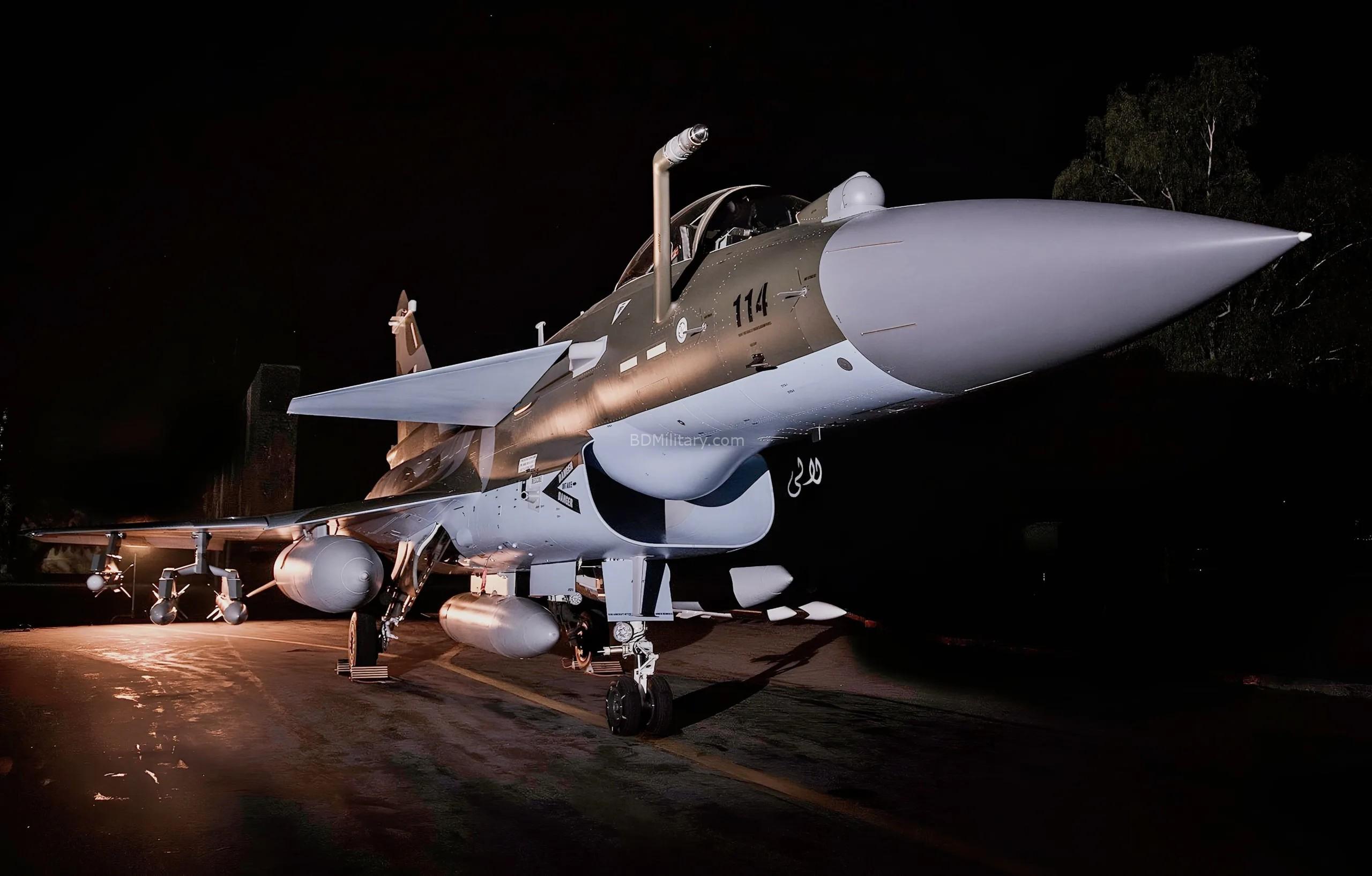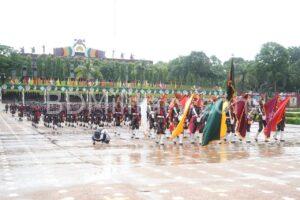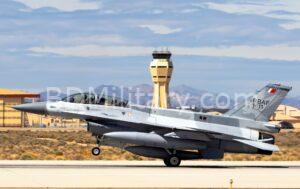The Bangladesh Air Force (BAF) stands at a decisive juncture in its modernisation journey, with plans underway to significantly expand and diversify its air combat capabilities. Today, Air Chief Marshal Khan, Chief of Air Staff of the Bangladesh Air Force, is expected to meet with the Chairman of CATIC (China National Aero-Technology Import & Export Corporation) and other senior representatives of China’s leading aircraft manufacturers. The discussions are reported to focus on two key platforms: the Chengdu J-10CE and the JF-17 Thunder Block III.
Background: Towards a Modern Multi-Role Fleet
Bangladesh’s ambition to build a capable and balanced air force has been a long-term objective under the Forces Goal 2030 modernisation programme. The intent is to transform the BAF from a limited air defence force into a modern, networked, and flexible service able to undertake defensive and offensive air operations independently.
In recent years, the Air Force has successfully inducted a range of new systems including Russian Yak-130 jet trainers, Italian Leonardo radar systems, and Chinese K-8W light attack aircraft. However, the need for a new generation of multi-role fighters capable of meeting regional security challenges has become increasingly pressing.
Against this backdrop, the BAF’s reported plan to procure 20 J-10CE fighters from China, in a deal estimated to be worth around USD 2.2 billion, marks a major step forward. The package is expected to include comprehensive training, spares, weapon systems, maintenance support, and the establishment of new infrastructure to accommodate the aircraft at key bases across the country.
The J-10CE: A Leap in Capability
The Chengdu J-10CE, the export variant of China’s J-10C, represents a significant technological leap for the Bangladesh Air Force. It is equipped with an AESA (Active Electronically Scanned Array) radar, advanced electronic warfare suites, and compatibility with a wide range of precision-guided munitions including beyond-visual-range air-to-air missiles (BVRAAMs).
With a delta-wing and canard configuration, the J-10CE offers exceptional manoeuvrability and agility. Its integrated avionics architecture allows for modern combat data-linking, giving it strong interoperability potential with AEW&CS platforms and ground-based radar networks.
The J-10CE has already entered service with the Pakistan Air Force, which operates over two dozen units, providing a useful regional reference for its operational performance and logistical sustainability. For Bangladesh, adopting this platform would mean access to a proven fourth-generation-plus multirole fighter with strong after-sales support and favourable terms compared to Western alternatives.
Rethinking the JF-17 Block III
Reports suggest that the Bangladesh Air Force has also evaluated the JF-17 Block III, another Chinese-origin fighter co-developed with Pakistan. While the JF-17 is widely recognised for its affordability and versatility, the platform is optimised for lower-cost operations and export markets.
Given the BAF’s evolving strategic needs and limited financial bandwidth, maintaining two separate lightweight Chinese fighter platforms may not yield optimal results. Instead, consolidating the investment in a single, more capable type such as the J-10CE could enhance operational efficiency, simplify logistics and training, and strengthen combat effectiveness.
Should the Air Force redirect resources towards additional J-10CEs, the fleet could be expanded to 36 aircraft, forming three full-strength squadrons. Such a move would establish a unified, high-capability backbone for the service, while allowing for standardised maintenance, munitions, and pilot conversion pathways.
Diversification and Strategic Balance
While Chinese platforms offer cost-effectiveness and rapid delivery timelines, Bangladesh’s long-term defence strategy must also account for supplier diversification. Overdependence on any single source poses strategic risks, particularly in times of political or regional tension.
For this reason, the BAF’s interest in acquiring the Eurofighter Typhoon Tranche 3 (TR3) represents an important strategic counterbalance. The Typhoon is one of the most advanced multi-role fighters in service today, with proven combat records in Europe, the Middle East, and Asia. Its acquisition would also align Bangladesh with Western aerospace technologies, offering exposure to NATO-standard systems, training, and operational doctrines.
An initial purchase of 10 Eurofighter Typhoon TR3 aircraft would significantly enhance the Air Force’s deterrence capability. Moreover, the possibility of later acquiring upgraded TR4 or TR5 variants within five years could ensure that the BAF remains abreast of future technological developments. This mixed-fleet strategy — combining Chinese and European aircraft — mirrors the balanced procurement policies of Pakistan, Indonesia, and Malaysia, which maintain strategic flexibility by sourcing defence equipment from multiple blocs.
Enhancing Airborne Surveillance and Networked Warfare
Modern air operations depend not only on capable fighters but also on the ability to detect, coordinate, and control engagements across a wide battlespace. To that end, the acquisition of an Airborne Early Warning and Control System (AEW&CS) should be considered a top priority.
Two suitable candidates stand out: the KJ-500 from China and the Saab Erieye from Sweden. The KJ-500 offers 360-degree radar coverage, advanced electronic countermeasures, and a robust communication suite. The Erieye, meanwhile, has proven performance in regional air forces such as Pakistan’s and provides interoperability advantages with Western systems.
An AEW&CS platform would greatly enhance the effectiveness of both J-10CE and Eurofighter operations by providing real-time situational awareness, target tracking, and coordinated response capabilities. It would effectively transform the BAF into a networked air force capable of conducting complex, multi-layered operations.
Technology Transfer and Local Industrial Capability
To ensure sustainability and self-reliance, Bangladesh should prioritise technology transfer (ToT) agreements within its procurement contracts. The production of components, sub-systems, or even munitions related to the J-10CE could be partially localised through partnerships with Chinese defence firms.
Such cooperation would not only reduce long-term maintenance costs but also contribute to developing Bangladesh’s domestic aerospace industry. Over time, local facilities could handle structural maintenance, radar servicing, and weapon integration, laying the foundation for limited indigenous production capability.
This approach aligns with global trends where smaller nations develop maintenance and assembly lines to reduce foreign dependence and enhance economic returns from defence spending.
Ground-Based Air Defence and Integrated Protection
A modern air force must operate in conjunction with an equally capable ground-based air defence network. The BAF, alongside the Bangladesh Army’s Air Defence Command, should explore the acquisition of modern medium- and long-range surface-to-air missile systems.
The Hisar-O+ MRSAM and Siper LRSAM, developed by Türkiye’s ASELSAN and ROKETSAN, offer modular and scalable solutions for layered air defence. These systems could provide effective protection for air bases, critical infrastructure, and population centres against aerial threats including cruise missiles and UAVs.
Integrating these systems with radar networks and AEW&CS aircraft would ensure seamless coordination between airborne and ground-based elements, establishing a credible deterrence posture.
The Role of UAVs and Emerging Technologies
Unmanned Aerial Vehicles (UAVs) have become indispensable assets for intelligence, surveillance, and reconnaissance (ISR) missions. Bangladesh has already expressed interest in Medium Altitude Long Endurance (MALE) UAVs from China, and acquiring a local production line would be a logical next step.
Domestic production of UAVs would provide cost-effective and sustained access to ISR capabilities, allowing the BAF to monitor border regions, maritime zones, and other strategic areas continuously. Additionally, UAVs could be integrated into strike and electronic warfare roles, particularly when paired with AI-driven mission planning systems.
Investment in artificial intelligence (AI) and cyber warfare capabilities should also be accelerated. As modern warfare increasingly relies on information dominance and digital resilience, the BAF must develop expertise in electronic countermeasures, cyber defence, and autonomous systems integration.
Conclusion: Building a Balanced and Capable Force
The Bangladesh Air Force’s ongoing procurement initiatives mark the beginning of a transformative phase in its development. By pursuing a fleet structure built around 36 J-10CEs, 10 Eurofighter Typhoons, and an AEW&CS platform such as the KJ-500, the service would achieve a balanced blend of capability, reliability, and strategic autonomy.
Complementary investments in air defence systems, UAV production, and cyber infrastructure would further enhance overall national defence resilience. Importantly, these efforts must be guided by a coherent long-term strategy that balances immediate operational needs with industrial and technological growth.
The proposed structure reflects a pragmatic and forward-looking approach — one that seeks to establish the Bangladesh Air Force not merely as a regional air power, but as a technologically advanced and strategically balanced service capable of safeguarding the nation’s skies for decades to come.
Annex: Recommended Force Structure and Procurement Overview
| System / Platform | Type / Role | Proposed Quantity | Estimated Value (USD) | Origin / Supplier | Remarks |
|---|---|---|---|---|---|
| Chengdu J-10CE | Multirole 4.5-gen Fighter | 36 aircraft | $2.92 billion (total) | China (CATIC) | Backbone of BAF; includes training, spares, and munitions. |
| Eurofighter Typhoon TR3 | Multirole / Air Superiority Fighter | 10 aircraft (expandable) | $1.8–2.0 billion (initial) | UK / EU Consortium | Diversification platform; future upgrade to TR4 or TR5. |
| KJ-500 AEW&CS | Airborne Early Warning & Control System | 1 aircraft (initial) | $250–300 million | China | To enhance situational awareness and networked operations. |
| Hisar-O+ MRSAM System | Medium-Range Surface-to-Air Missile System | 2–3 batteries | $300 million (approx.) | Türkiye (ASELSAN) | Modular mid-range air defence system. |
| Siper LRSAM System | Long-Range Surface-to-Air Missile System | 1–2 batteries | $400–450 million | Türkiye (ROKETSAN) | Long-range strategic air defence. |
| MALE UAV Production Line | Unmanned Aerial Vehicle (Recon/Strike) | Local line setup | $150–200 million | China / Local JV | For sustained ISR and strike capability. |
| Cyber & AI Warfare Capability | Digital Defence Infrastructure | Continuous investment | Ongoing development | Indigenous / Allied Support | Enhances resilience and command automation. |
Summary of Recommendations
- Proceed with Eurofighter Typhoon TR3 procurement to ensure strategic diversity.
- Consolidate fighter fleet around the J-10CE for efficiency and combat coherence.
- Acquire AEW&CS capability to enable full-spectrum air dominance.
- Develop a layered air defence architecture using Hisar-O+ and Siper systems.
- Accelerate UAV production, AI integration, and cyber warfare capabilities.
- Pursue technology transfer agreements to strengthen domestic defence industries.

Khaled Ahmed is a seasoned former intelligence analyst and military expert from the Netherlands, bringing over 15 years of specialised experience in operational intelligence, threat analysis, and strategic defence planning. Having served in high-level, classified roles within Dutch military intelligence, he possesses rare expertise in European security architecture, NATO doctrine, and asymmetric warfare. Khaled’s deep operational insight and international perspective enable him to deliver precision-driven intelligence analysis and forward-looking strategic forecasts. A trusted contributor to high-level risk assessments and security briefings, he offers readers clarity on complex defence and security challenges. Khaled leads the National Security and Fact Analysis sections at BDMilitary. He holds a Master’s degree in International Relations from the University of Groningen, The Netherlands, and is fluent in Dutch, French, and Arabic — combining linguistic dexterity with operational expertise to analyse security issues across cultures and regions.


